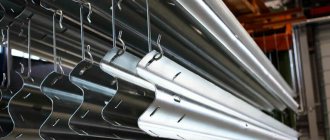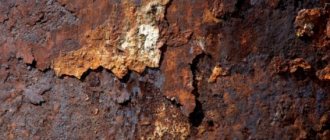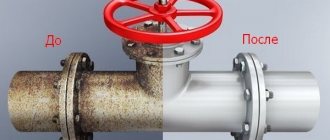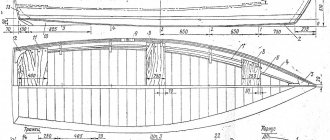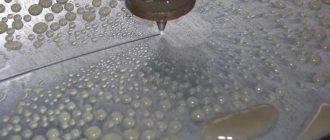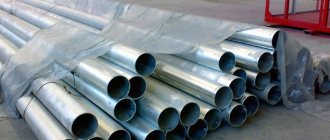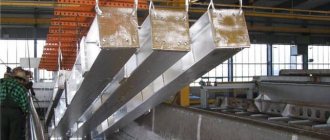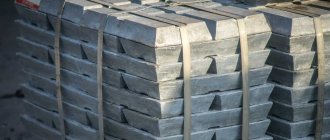Iron and steel are the materials from which the skeleton of modern technological civilization is made. But - alas! — and the steel foundation of our civilization has its own weak spot. It is called corrosion, from which iron and steel do not have the natural protection that the oxide film provides for many non-ferrous metals - tin, zinc or aluminum.
Steel needs protection from corrosion - and the best protection for it is galvanizing. (or galvanized). Galvanized sheets will last much longer than regular steel sheets.
Ads for “galvanizing” in Russia
Meanwhile, galvanizing of parts in Moscow, and throughout Russia, remains a specific service.
The problem is that this procedure is quite difficult to perform at home. However, supply is born of demand, and many online service sites are bursting at the seams with advertisements like “we will galvanize metal.” Moreover, there is often nothing hidden behind the promise to do it and the tempting price. Social networks offer no less scope for choice, where today everyone actively advertises their services - from private craftsmen to enterprises. The right choice should be based on a comparison of price and quality. Moreover, it is better to judge the second nuance only by real, and not by custom-written reviews.
Dip galvanizing
This technology is based on the centrifuge method. Initially, the parts are cleaned of various contaminants, then fluxed, dried, placed in a perforated basket and immersed in molten zinc.
At the end of the reaction, the container with the parts is placed in a centrifuge, in which excess zinc is removed from their surface (the rotation speed of the drum is 400 - 600 rpm). At the final stage, the parts are poured into a bath filled with water.
Processing small parts using this technology has a number of disadvantages:
- Automatic assembly of products becomes almost impossible, since they stick together in a common mass;
- A large amount of thermal energy is consumed per product;
- The thickness along the entire length of the parts is non-uniform, which significantly reduces the duration of protection against corrosion.
The essence and purpose of the metal galvanizing process
Galvanizing is based on anodic coating technology, in which the metal surface is coated with metal particles with lower electrode properties.
The main enemy that this method of protection is designed to combat is high humidity. Forming a galvanic couple with the metal surface, the zinc coating completely blocks access to it. It takes the brunt of the blow, and even when destroyed, it does not give up its position: zinc hydroxide is formed in the damaged areas, which is also known for its good protective functions.
Features of the galvanizing procedure and the main methods of metal protection
Metal corrosion, or the process of its oxidation, is especially intensified in conditions of high humidity. To prevent corrosion of metal products, protective coatings are applied to them. Galvanizing of metal is considered one of the most reliable, since zinc takes on the effects of aggressive environments. Galvanizing provides not only barrier, but also electrochemical protection of the metal. During the reaction, an oxide layer appears on the surface of the part, which provides additional protection.
After mechanical destruction of the coating, the effect of the protective layer ceases. There are various types of metal galvanizing, many of them require complex and expensive equipment, but some can also be used at home.
Galvanized pipes
Galvanizing technology was first mastered in France in the 18th century and further developed in England. Domestic scientists Jacobi and Mendeleev made a great contribution to improving the process. Today, galvanizing metal is one of the most affordable ways to protect against corrosion.
Galvanizing services in Moscow, advantages of contacting our company
Our metalworking shop guarantees you truly high-quality galvanizing of parts. Your metal will receive full protection, rather than a slight camouflage effect, and the coating will retain its physical properties for decades. At your disposal:
- the most modern technologies and galvanizing lines;
- the possibility of applying a zinc layer of various thicknesses - depending on the characteristics of the future operation of the products;
- the ability to produce galvanized steel in batches - tens and even hundreds of tons per day.
Electrochemical galvanizing
Using this technology for processing small products, it is possible to obtain a coating whose thickness does not exceed 10 - 15 microns. However, this thickness of the protective layer is not sufficient for the parts to be used for external fastening.
Of course, the technique makes it possible to create coatings of greater thickness, but this requires increased electrical energy consumption. It is also worth considering that waste solutions contain complexons, which complicate the process of processing solutions.
Sherardization technology (thermal diffusion galvanizing) allows you to create uniform protective coatings of sufficient thickness (25 - 30 microns), eliminating the possibility of parts sticking together. However, this processing method also involves increased consumption of thermal energy required to heat the equipment, as well as regular repairs of work boxes.
In addition, the relatively low level of use of zinc powder does not allow the use of technology to provide reliable anti-corrosion protection of fastening elements.
Galvanizing methods and methods
It is no coincidence that we mentioned “technologies”: the list of methods for modern galvanizing of parts in Moscow is quite wide.
In addition to the traditional and most famous “hot” and “cold” methods, these include galvanic, thermal diffusion and gas-thermal. Which method should you prefer? It depends on the requirements for the zinc layer. And they, in turn, are determined by the conditions in which the parts will have to work. Thus, the required coating thickness will depend on the characteristics of the working environment and the duration of its exposure to the metal. If they are in constant contact, then the galvanization of metal in Moscow should be maximum. It is also worth remembering about the rapid wear of the zinc layer with constant mechanical impact on it.
Do-it-yourself galvanizing
As already mentioned, some types of galvanizing can be done independently at home. This applies to cold galvanizing technology or the electrochemical method.
To perform galvanizing yourself using an electrical method, you need to carefully prepare the surface of the workpiece. Preparation includes:
- cleaning;
- degreasing;
- acid pickling;
- rinsing under running water.
You can make an apparatus for galvanic galvanizing yourself based on a direct current source with a voltage of 6-12 V at a current strength of 2-6 A and a capacitance based on a dielectric device and a device for fixing the product and electrode. Any salt solution containing zinc acts as an electrolyte. To prepare the solution, zinc is placed in a battery electrolyzer and dissolved in it. Before use, the composition is filtered.
When performing galvanizing with your own hands, you need to take into account that the following factors influence the quality and thickness of the coating:
- current density per unit area of the product;
- temperature of the electrolytic solution;
- electrolyte temperature;
- geometry and complexity of the product shape.
Galvanizing metals allows you to slow down the process of corrosion of products. Galvanizing methods depend on the operating conditions of the products. You can galvanize materials at home.
Hot galvanizing of metal and products
Hot galvanizing is not used as often as cold galvanizing, although it is much more effective in terms of the quality of the applied coating.
The reason is the low environmental friendliness of this process. And not just one, but two stages at once: treating the metal surface with strong reagents and immersing it in zinc. The latter is especially harmful, since under the influence of high temperature the liquid metal releases vapors into the atmosphere. Professional hot-dip galvanizing of parts that is absolutely harmless to humans and the environment can only be carried out at production facilities. Where, firstly, all personnel protection rules are observed, and secondly, the ventilation system required by SanPiN is equipped.
Why zinc?
First of all, because zinc is quite common and inexpensive, it itself is practically resistant to corrosion, melts at a not very high temperature (about 420 degrees, which is much lower than the melting point of iron), and has acceptable strength. And at the same time - what is important! - has a stationary electric potential of -0.76 V, that is, much more negative than that of iron.
Due to this property, zinc, even if the integrity of the coating is damaged and under the influence of electrolytes, will play the role of an anode in the resulting electrochemical reactions. That is, it will slowly dissolve, thereby protecting the steel base of the structure from electrochemical corrosion. In general - give us zinc coatings! Just in what ways to apply them? This is a rather interesting question, since there are several such methods - and each of them has its own pros and cons. Let's consider them...
Cold galvanizing of metal and products
A more popular method is to obtain galvanized parts using the cold galvanizing method.
This method is not much inferior to the previous one in efficiency, but is not at all labor-intensive: the simplest galvanization can be applied to metal even in a garage. Without requiring the purchase of special equipment, the technology provides metal products with good protective properties. Cold galvanizing is somewhat similar to painting, since with it the surface is coated with a composition containing liquid zinc. For small parts, a paint brush or roller is usually used; for large volumes or hard-to-reach places, a spray gun is used. If protection of large-sized structures is necessary, this method is, in fact, without alternative. Especially for static elements that are already mounted.
Electroplating with zinc (zinc plating, galvanizing) in neighboring regions
For a service such as galvanizing, the price of performing work in Moscow and the regions remains at approximately the same level.
However, some enterprises in the Moscow region and neighboring regions offer good discounts for this treatment. But before taking advantage of their offers, we advise you to weigh the pros and cons. First, study reviews about the contractor and evaluate his experience in the market. Secondly, keep in mind that when ordering galvanizing, a geographically distant enterprise will have to incur costs for delivering blanks to the workshop and transporting finished products to its premises. With constantly rising gasoline prices, transportation can eat up a significant portion of your budget.
We perform yellow galvanizing in Moscow and simple galvanizing at very competitive prices for the customer. In addition, we take upon ourselves the solution of the transport issue. Is it worth going somewhere if acceptable offers are practically at hand?
Thermal diffusion galvanizing of metal and products
The thermal diffusion method of galvanizing parts was invented almost a century ago, but was considered ineffective for a long time. And only decades later it was appreciated, and today it is used as actively as the methods described above. Zinc in this case is a powder composition. Together with the parts or part, it is loaded into an impenetrable container and the temperature inside is raised to an “extreme” +2600 degrees. As a result, the zinc powder changes from a solid to a gaseous state.
Thermal diffusion galvanizing
The main disadvantage of galvanic galvanizing, “hydrogen embrittlement,” is avoided by thermal diffusion galvanizing technology.
It is based on the fact that zinc, under certain conditions, can evaporate from the surface of a zinc-containing powder and penetrate into the surface layers of iron, resulting in the formation of a complex zinc-iron alloy.
Such diffusion becomes possible when
high (from 290 to 400 degrees) temperature and the presence of electrical potential, at which steel products act as an anode.
The thermal diffusion process is carried out in a rotating container at reduced pressure (0.1 atmosphere) in a reducing hydrogen atmosphere. Thermal diffusion galvanizing of each batch of fastening hardware requires from 90 to 180 minutes.
As a result, these parts will acquire a mouse-gray color - but with it, increased surface strength and excellent corrosion resistance (3-5 times better than with galvanic galvanizing and one and a half to two times better than with hot-dip galvanizing).
In this case, the uniformity of the coating will be ideal, and there is no point in talking about the adhesion of such a coating - it simply “merges” with the ferrous metal, so it is simply impossible to separate it from it. Of course, the appearance of hardware galvanized in this way does not bring much aesthetic pleasure, but bolts, nuts, springs and screws are not required to be particularly beautiful.
Thermal-diffusion galvanizing has only one drawback, but it is significant - due to the nature of the technology, it can only be used for small-sized objects.
A simple way to galvanize at home
You can apply a zinc coating to metal at home. But, as you might guess, in this case there is only one way to obtain galvanized parts - cold. All others require the use of expensive equipment. Despite the apparent simplicity of cold galvanizing, which is so similar to conventional painting, many beginners often fail because they forget to treat the surface or do it incorrectly. To achieve a high-quality result, we still recommend turning to professionals.
Electroplating with zinc (zinc plating, galvanizing)
Galvanizing and galvanizing are based on an electrochemical process.
In a specially created liquid medium—an electrolyte—zinc is deposited onto a workpiece that has a negative charge. If decorative properties are important, and not just the formation of a protective coating, galvanizing can be complemented by processes such as cadmium plating, chromating and phosphate treatment. Most often, galvanic galvanizing, the price of which in the capital is affordable for customers with any budget, is performed for cast iron and low-carbon steels - alloys that are most vulnerable to corrosion. Aluminum is also processed in this way - an already corrosion-resistant and aesthetic material.
As for the range of metal products, most often they order the processing of small parts: for example, galvanic galvanizing of hardware. Traditionally, tools, pendants, brackets, various types of supports and car parts are also galvanized.
How to distinguish galvanized metal from regular metal
Over time, the zinc layer becomes dull, and it becomes difficult to visually distinguish it from unprotected steel.
Let's say you want to buy galvanized, but not new, although high-quality rolled steel. How to determine that it has really been galvanized? The easiest way is to hold a magnet to the metal. Unprotected steel will exhibit a magnetic effect, but zinc, known for its non-magnetic properties, will be indifferent to this experience. Finally, you can check the galvanization of a part in another simple way, although it will probably surprise the seller: you can lick the surface of the metal. Galvanization has a pronounced chalky taste.
We have described only the simplest and “instant” ways to check for galvanization. Others require time or the use of laboratory equipment.
Order metal galvanization from Tochinvest Zinc
When contacting our company, all clients receive the following benefits:
- The capacity of our company reaches 120,000 tons per year, which allows us to quickly carry out work in compliance with the agreed deadlines.
- The company is equipped with 3 production workshops for hot-dip galvanizing of small parts and large structures.
- We are the only company that has the deepest bathtub in the Central Federal District - 3.43 m.
- The coating using hot-dip galvanizing technology is applied taking into account the requirements regulated by GOST 9.307-89.
- Since 2007, only high-tech equipment from the German-Austrian company KVK KOERNER and the Czech company EKOMOR has been used in production.
You can find out more about the cost of processing and the timing of the work by calling the numbers listed on the website.
Call! Return to articles Share article
The birth of electroplating in Russia and the world
Galvanic galvanizing in Moscow is only a small link in the history of galvanic technologies.
The starting point of world electroplating can be considered the 80s of the 18th century, when the discoverer of the process, the Italian Luigi Galvani, invented an element that was later named after him. Another legendary scientist, also an Italian, A. Volta, at the turn of the century introduced the first galvanic battery to the scientific community - the so-called “voltaic column.” Our compatriot V. Petrov made a significant contribution to research, who designed a similar battery, but of very impressive size. Galvanic technology of the 19th century is also associated with the name of the Russian German Boris Jacobi, the father of galvanoplasty.
The research of these brilliant minds, in fact, formed the basis for the future of galvanic galvanizing, the price of which for modern metalworking is difficult to express in nominal terms, even with a huge number of zeros.
Why is metal galvanized?
Steel products are known to be very vulnerable to corrosion, especially when used in damp environments. Galvanizing steel gives this metal reliable protection from destruction. Zinc, reacting with steel, forms a galvanic couple with it and acquires a greater degree of electronegativity than steel.
It is zinc that takes the first blow from aggressive factors, while steel does not react and remains protected by the zinc coating. Accordingly, the anti-corrosion protection will remain in effect until the galvanization is completely destroyed. But even in those places on the steel surface where it wears off, zinc reacts with oxygen and water to form zinc hydroxide. This connection also does a good job of protecting the surface of the steel product from corrosion.
Disadvantages of galvanic galvanizing
Despite the many advantages that a protective coating gives the metal, galvanizing based on galvanization also has its disadvantages.
We have already mentioned one of them—restrictions on product dimensions. In addition, zinc has a fairly low level of adhesion to any metal, and in order to obtain a durable layer, the surface of the workpiece must be carefully cleaned. But for professional production this is not a problem. This method of producing galvanized steel can hardly be considered environmentally friendly: during the contact of zinc plates with electrolyte substances, toxic fumes are released into the atmosphere. These once again prove that for any galvanizing, including yellow galvanizing, it is better to contact specialists.
Galvanizing on hangers
However, the method of galvanizing fasteners described above is not always acceptable. As the workpieces move inside the drum, they inevitably come into contact with each other. There is a danger of their abrasion. What will be the value of protective coating, galvanizing, if the parts themselves are mechanically damaged? In this case, galvanizing on hangers is used as an alternative method. It will be appropriate when:
- external threads are applied to the parts,
- increased demands are placed on their strength characteristics,
- it is necessary to achieve maximum coating uniformity and corrosion resistance;
- The attractive appearance of the products is extremely important to the customer.
Wire galvanizing. Wire hot-dip galvanizing lines
Technical specifications
| The diameter of the wire: | 1.40~6.00mm |
| Wire material: | Low carbon steel |
| Melt: | Galfan (Zn - 95%; Al - 5%) |
| Number of wire threads: | 20 |
| Number of working hours per year: | 7200 |
| Performance: | 1000 t/m |
| Coating thickness: | 50 ~ 200 g/m² |
| D.V. | 60 — 100 |
| Energy carrier | Natural gas |
| Gas consumption | 600 m³/h |
| Electricity | 380 V, 3 phases, 50 Hz |
| Electricity consumption | 200 kW/h |
Technological process
Unwinding → electrolytic degreasing (length 10 meters) → washing → annealing → cooling → galvanizing → cleaning, cooling → coiling.
Description of equipment
Unwinding
A vertical unwinding device equipped with tension control is used. A total of 24 sets of vertical unwinders are supplied. 20 sets are installed in the line, and 4 sets are spare. The maximum weight of the bay is about 800-1000 kg. Length 16 meters.
Electrolytic degreasing
The bathtub is made of reinforced polypropylene. Dimensions L x W x H: 10000 x 800 x 800 mm.
The electrolytic degreasing process is used to quickly and effectively remove oil from the wire surface.
To obtain an absolutely clean steel wire without any surface contamination, it is necessary to adjust the electrical density.
The cathode and anode are made of stainless steel.
The solution is heated using electrical heating and an additional heat exchanger. The installation uses automatic temperature control of 60-70°C. Length 10 meters.
Washing with water
The bathtub is made of reinforced polypropylene. Dimensions L x W x H: 2000 x 800 x 800 mm.
Serves to clean the wire from residual contaminants and remove residual degreasing solution. In order to prevent water from entering the next working process, the water outlet grooves are equipped with double rubber coating, which prevents residual cleaning water from entering the surface of the steel wire.
Electricity and a heat exchanger are used for heating. The washing unit is equipped with two sets of corrosion-resistant pumps. The installation uses automatic temperature control of 60-70°C.
Length 2 meters.
Annealing
The annealing furnace is a tubular muffle furnace. The pipe material is heat-resistant steel.
Inside the pipes there is a protective gas obtained from the breakdown of liquid ammonia, which creates a protective atmosphere around the wire. In the heating zone, the temperature of the steel wire reaches 680°C, and then the steel wire is cooled in a protective atmosphere to 450-500°C and enters the galvanizing bath.
All furnaces are made of refractory bricks and mullite, lined with ceramic fiber, and externally covered with steel sheets.
Gas flat-flame burners are used for heating in the furnace. Heating occurs proportionally to the furnace sections. The oven temperature is controlled automatically.
Length 32 meters.
Galvanizing furnace
The galvanizing furnace consists of a ceramic galvanizing bath and a furnace body equipped with a gas heating system and a temperature control system.
To measure the temperature in the galvanizing bath, a corrosion-resistant type K measurement thermocouple is used. The thermocouple is in direct contact with the molten zinc.
Galvanizing furnace size:
Internal dimensions of the ceramic bath: 2500 x 800 x 1100 mm (L x W x H) External dimensions of the galvanizing furnace: 4500 x 2200 x 1500 mm (L x W x H) Amount of molten zinc and aluminum: about 15 tons.
To ensure high strength and wear resistance, the tension drum is made of silicon nitride combined with silicon carbide ceramic overlay.
The tension drum allows you to adjust the angle of the wire exit.
Excess zinc is removed in an inclined direction with water and an asbestos fixative.
Vertical winding machine
Vertical reception system. Bobbin diameter: 650 mm. Number of reels: 20 pcs. Reception speed: 1-70 m/min., speed control. coils without stopping the receiving device.
Scope of delivery
| № | Position | Quantity | Note |
| 1 | Reel unwinder | 1 set (24 pcs.) | |
| 2 | Electrolytic degreasing bath | 1 kit | |
| 3 | Washing bath | 1 kit | |
| 4 | Annealing furnace | 1 kit | |
| 5 | Galvanizing bath | 1 kit | |
| 6 | Output frame | 1 kit | |
| 7 | Vertical winding machine | 1 kit | |
| 8 | Control cabinets | 1 kit |
